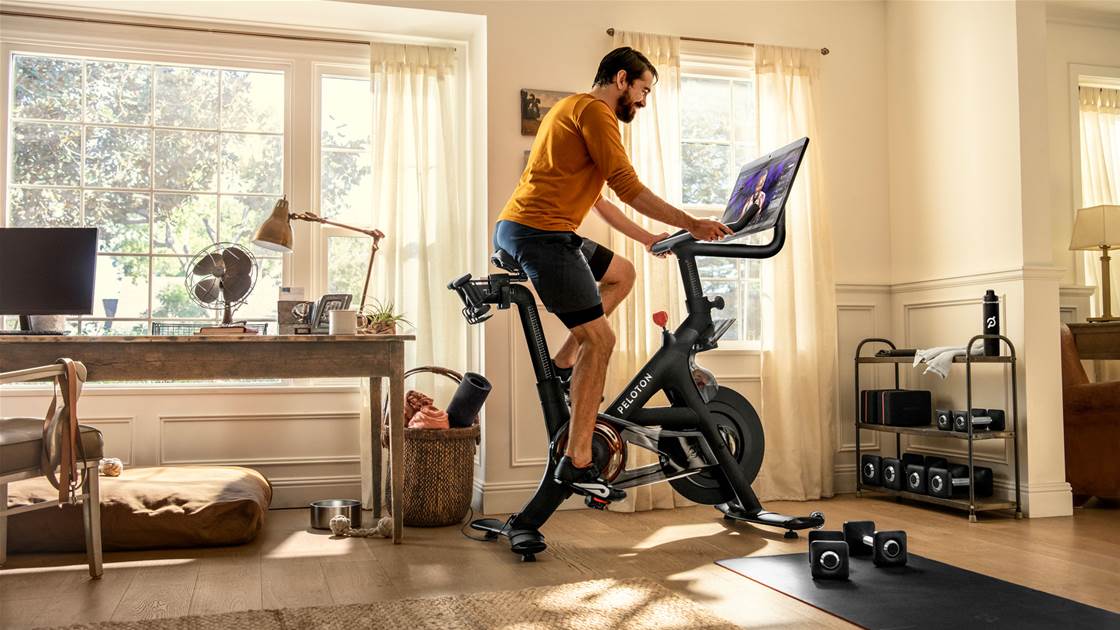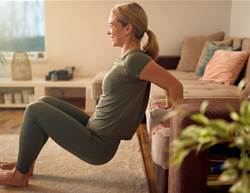Let’s get this straight: I am not a gym bunny. I’m an outdoorsy type who likes walking and swimming, but sweating it out at the gym isn’t for me. When I’ve tried gym memberships before, motivation has been pretty hard to come by. And TBH, I don’t have time for that. I’m juggling a busy job and two young kids so shlepping it to a gym just isn’t a priority, even though I really do care about my health and fitness.
So when I was given the chance to do a Peloton Bike review, I was a bit sceptical. It’s just an exercise bike, right? What’s so special about that? Within about a week, I was proven wrong.
The Peloton is an exercise bike, but with a big screen with thousands of exercise classes which are constantly being updated. First off, I did all of the Taylor Swift rides, of course. They were upbeat and fun and surprisingly motivating. Then I tried a few scenic rides around the world and moved on to some pop music-themed interval training. My personal goal was to do it three times a week for 30 minutes and this was much easier than expected.
The rides themselves were not easy. Each ride got my heart rate up, made me sweat and gave me a burst of adrenalin by the end. But the Peloton Bike is expensive and not for everyone. Is it worth it? Here we go through the pros and cons of a Peloton, plus the health benefits of stationary bikes and how to get the most of your workout.
The cons
Chatty instructors: While the instructors were motivating, especially when paired with my favourite music, I found them far too chatty across the board. They talk almost constantly through the workouts, sometimes to explain the section but just as often singing along to the music or sharing their trite life philosophies with you. As they were mostly American it may be a culture clash, but for the most part I found this annoying.
You can increase the volume of the music and tone down the instructor but I found this was like hearing half of a conversation, so it wasn’t helpful. Once I’m comfortable with a favourite class, I might just pair with my Spotify account and listen to my own music.
Cleats: To use a Peloton bike you need special bike shoes that lock into the pedals. I found this a bit claustrophobic being stuck there, especially as for the life of me I couldn’t unclip the shoes the way you’re supposed to. I had to loosen the top straps and slip my feet out, leaving the shoes dangling on the pedals. Do I just have weak ankles? Am I the only one that struggles with this? Not sure.
Beginner pains: At first, I had what one instructor called a sore “undercarriage”. But these pains soon went away as I got used to the bike.
Exercising without oversight: Although the Peloton is low impact, and therefore good for people with injuries, you are left to your own devices with a new workout routine says Veronika Larisova, an exercise physiologist and co-founder of Chief Nutrition.
“People with specific injuries, such as acute hip or lower spine problems, should consult a healthcare provider to ensure that cycling is appropriate for their recovery stage,” says Larisova.
Posture and form: If you set your bike up incorrectly, it could lead to “poor posture, discomfort or injury,” says Larisova. The bike comes with in instruction video for adjusting your bike but it would be helpful to have an expert check your form.
While cycling is a great exercise, Larisova recommends combining it with other forms of exercise (like strength training and stretching) to avoid repetitive strain injuries and muscle imbalances. Combining cycling with strength training also ensures you’re supporting your bones, as well as cardiovascular and muscular endurance.
Cost: The Peloton is an investment. I trialled the Bike+, which has a large rotating screen and as automatic resistance control (so you don’t have to keep twiddling with the resistance knob mid-workout). It costs $3,699 for the Bike+ as well as $59 a month for access to the classes.
This totals $4,407 for the first year and $708 a year after that. The average cost of a gym membership in Australia is $756. The Peloton Bike is cheaper upfront at $2,699.

The pros
Convenience and efficiency: The Peloton quickly filled a hole in my exercise program. While I was getting well above my 10,000 steps a day, I wasn’t really doing any moderate to vigorous cardio. Now I was. And as it was so convenient sitting right there in my bedroom, I was doing maybe 40% more exercise than I was before. Using it over winter was especially useful – on those rainy, windy days when even I couldn’t face a walk, there was no excuse not to do a quick session.
Previously I’ve seen a personal trainer once a week. If I had a gym membership, I wouldn’t be able to fit it in more than twice a week. But with the Peloton right there in my house, it was such a time-efficient way to exercise. I knew I could go and do a quick 30-minute ride and then be back at my home office or parenting in exactly 30 minutes.
Larisova agrees that it’s a very efficient workout as it raises “the heart rate quickly, especially with high-intensity interval training (HIIT) formats often found in Peloton or spin classes,” she says.
Variety of classes: I also loved that it wasn’t just cycling – turn the Bike+ screen around and you can do yoga, dance, weight training, shadowboxing and stretching. You can filter by music type or length – a quick five minute arm-toning weights class or a 60 minute cycling slog.
A Peloton is great for beginners, with several classes designed to help you get used to your bike and ease into using it. “The ability to vary resistance and speed makes it adaptable to various fitness levels, ensuring progress over time,” says Larisova.
My goal with the Peloton was to increase my fitness, and I certainly did that. My goal was also to stick with it, and I did find there was enough variety in classes to keep me motivated.
The health benefits of using a stationary bike
Larisova says using a stationary bike like a Peloton “offers a wide range of health benefits, particularly for cardiovascular health and muscle endurance”.
“Cycling strengthens the heart, increases lung capacity, and improves circulation. It can also lower blood pressure in individuals suffering from hypertension. Regular use helps reduce the risk of heart disease, stroke and hypertension. Stationary cycling can also burn a significant number of kilojoules making it an efficient exercise for weight loss and metabolic health.”
Exercise like this doesn’t just help reduce your risk of chronic disease, either. It’s great for your physical fitness and strength, too.
“Cycling enhances muscle endurance, particularly in the lower body, engaging the quadriceps, hamstrings, calves, and glutes. It also minimises joint strain, making it a suitable exercise for individuals with joint pain or conditions like arthritis,” she says.
“Cycling can also positively impact mental health, reducing symptoms of anxiety and depression, improving sleep quality and enhancing overall mood. Lastly, indoor cycling can also improve balance and coordination, particularly through increased core engagement and lower-body stabilisation.”
The verdict
I felt the pros outweighed the cons. I was able to use the Peloton without pain despite my various injuries, thanks to it being a low-impact exercise. I enjoyed the variety of classes and that I could do weight training classes, which balanced out my usual cardio exercise routine. And I loved that no matter how long you have, you can find a class to fit, from a quick five minute core class to a 60 minute cycling slog.
Yes, a Peloton Bike and the subscription is expensive, but it fit really well into my lifestyle and made it easy for me to get more exercise into my busy week. And that is priceless.
How to get the most out of your Peloton Bike workout
- First up, spend time adjusting the saddle and handlebars to the right position for you.
- Next, get your form right, says Larisova. “Focus on smooth, controlled pedalling, pulling up as well as pushing down on the pedals to engage more muscles and distribute force evenly across the legs. Maintain a neutral spine, keep your shoulders relaxed, and engage your core to avoid hunching or excessive gripping of the handlebars.”
- Stay hydrated, because a stationary bike workout makes you SWEAT.
- “Finally, regularly varying the intensity of your rides, from steady-state cardio to sprints, ensures continuous progress while minimising the risk of overuse injuries,” says Larisova.









